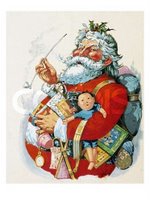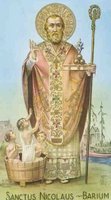The Commemoration of Saint Nicholas
Q. How did Saint Nicholas become “Santa Claus”?
 A: Because of language differences, you might say that Saint Nicholas has always been Santa Claus.
A: Because of language differences, you might say that Saint Nicholas has always been Santa Claus.Santa Claus is a distortion of Sinterklaas, the Dutch term for Saint Nicholas (Klaus of the Cinders). Santa Claus came into common usage through the Dutch settlers in New Amsterdam, later New York. The secret visits of Sinterklaas to Dutch children became a part of New York folk stories and easily migrated into general usage, spreading from the Hudson Valley across the country.
The image we moderns have of him comes in large part from the poem “A Visit from St. Nicholas” by Clement Moore and cartoons by Thomas Nast.
 Nicholas was Bishop of Myra in the Fourth Century AD. Coming from a wealthy family and wanting to serve God in physical poverty, he resolved to give away his inherited fortune. He became renowned for his generosity, especially toward the truly poor and needy. The stories tell us that whenever possible, he gave his contributions in secret.
Nicholas was Bishop of Myra in the Fourth Century AD. Coming from a wealthy family and wanting to serve God in physical poverty, he resolved to give away his inherited fortune. He became renowned for his generosity, especially toward the truly poor and needy. The stories tell us that whenever possible, he gave his contributions in secret.A classic story (probably not true, but typifying his reputed generosity) involves three sisters whose father wasted the family fortune. In those days, if a girl had no dowry — a sum of money to contribute to her intended husband — she had no way to marry into a respectable family. Normally, either slavery or prostitution might be her only means of support.
When Nicholas heard of their plight, he came sneaking up to the house after all were asleep and tossed sufficient dowry money through the windows so that the girls could each wait for a proper marriage. Some versions have him wrapping coins (and jewels) in stockings — beginning a tradition of gifts in stockings.
 The three bags of gold were later stylized into three golden balls, which passed into usage as the sign of pawnbrokers. Perhaps the connection is that those in dire financial straits often turn to such people in order to gain ready cash to tide them through their troubles.
The three bags of gold were later stylized into three golden balls, which passed into usage as the sign of pawnbrokers. Perhaps the connection is that those in dire financial straits often turn to such people in order to gain ready cash to tide them through their troubles.Besides being claimed by pawnbrokers as patron saint, Nicholas also has special ties to children (he was said to have raised three murdered boys from the dead) and sailors and dockworkers (since it was claimed that he once calmed a severe storm at sea).
His commemoration is his “heavenly birthday” or death day, 6 December AD 326. Parts of Europe and elsewhere use his feast as the day of gift giving, reserving Christmas solely for the true Gift, the Savior Jesus Christ.
Added note: For a bit more, including Lection and Collect, check this post from Aardvark Alley.
Send email to Ask the Pastor.
Walter Snyder is the pastor of Holy Cross Lutheran Church, Emma, Missouri and coauthor of the book What Do Lutherans Believe.

1 Comments:
Nice summary of Saint Nicholas. Roger S. Wieck's Book, Painted Prayers explains the leap from the three girls' dowery to resurecting the three beheaded boys:
"Nicholas's attribute of three purses of gold, sometimes depicted as yellow spheres, where mistaken as three tow-haired heads, thus giving birth to the story of the mutilated boys. According to tradition, an unscrupulous innkeeper had killed and dismembered three youths, storing their mangled bodies in a pickling tub as food for guests. Nicholas was able to bring the boys back to life simply by making the sign of the cross over the barrel."
Post a Comment
<< Home